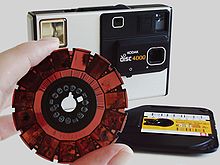

Disc film is a discontinued still-photography film format that was aimed at the consumer market. It was introduced by Kodak in 1982. [1]


Disc film is a discontinued still-photography film format that was aimed at the consumer market. It was introduced by Kodak in 1982. [1]
The film is in the form of a flat disc, and is fully housed within a plastic cartridge. Each disc holds fifteen 10 × 8 mm exposures, arranged around the outside of the disc, with the disc being rotated 24° between successive images.
The system was a consumer-oriented product, and most cameras are self-contained units with no expansion capability. The disc film allows them to be compact and considerably thinner than other cameras. The cameras are very simple to load and unload, and are generally completely automated. The cassette has a built-in dark slide to prevent stray light reaching the film when the disc is removed.
As the film is rotated on a disc instead of over a spool, the cassette is very thin. The flat nature of the format also led to the potential advantage of greater sharpness over curved spool-based cassette formats (such as Minox film, 110 and 126 film). Disc film has a very thick acetate base, comparable thickness with 4×5" sheet film, which holds the film much flatter than the other formats of the time.
Disc film did not prove hugely successful, mainly because the image on the negative is only 10 mm by 8 mm, leading to generally unacceptable grain and poor definition [2] in the final prints from the analog imaging equipment used at the time. The film was intended to be printed with special six-element lenses from Kodak, but many labs simply printed discs with standard three-element lenses used for larger negative formats. The resulting prints often disappointed the consumer. Few labs made the investment required to get the best out of the small negative size. A problem with labs of the time was the manual nature of processing the color negative film. This was essentially a manual process, unlike spool-based films, whose chemical processing could be fully automated.
There were several different manufacturers of disc film. Kodak produced films throughout the complete lifespan of the format, but 3M, Konica and Fuji [1] also produced disc film. While Kodak film was always eponymous, 3M and Konica made disc film for many third parties, branded with the retailer's logo. As with most photographic film, for such white-label products the country of manufacture provides the best indication as to the actual manufacturer.
The film was officially discontinued by the last manufacturer, Kodak, on December 31, 1999, though the cameras had disappeared from the market long before then.
The 1983 "Minolta Disc-7" camera introduced a predecessor of the selfie stick—a convex mirror on its front to allow the composition of self-portraits, and its packaging showed the camera mounted on a stick while used for such a purpose. [3]
In 2012, Hèrm Hofmeyer in The Netherlands and Film Rescue International in Canada cooperatively developed a method to produce fresh disc films, and about 30 fresh B&W and colour discs were made. A detailed protocol on how to manufacture such discs at home was released in 2020. [4]

Film stock is an analog medium that is used for recording motion pictures or animation. It is recorded on by a movie camera, developed, edited, and projected onto a screen using a movie projector. It is a strip or sheet of transparent plastic film base coated on one side with a gelatin emulsion containing microscopically small light-sensitive silver halide crystals. The sizes and other characteristics of the crystals determine the sensitivity, contrast and resolution of the film. The emulsion will gradually darken if left exposed to light, but the process is too slow and incomplete to be of any practical use. Instead, a very short exposure to the image formed by a camera lens is used to produce only a very slight chemical change, proportional to the amount of light absorbed by each crystal. This creates an invisible latent image in the emulsion, which can be chemically developed into a visible photograph. In addition to visible light, all films are sensitive to X-rays and high-energy particles. Most are at least slightly sensitive to invisible ultraviolet (UV) light. Some special-purpose films are sensitive into the infrared (IR) region of the spectrum.

8 mm film is a motion picture film format in which the film strip is eight millimetres (0.31 in) wide. It exists in two main versions – the original standard 8 mm film, also known as regular 8 mm, and Super 8. Although both standard 8 mm and Super 8 are 8 mm wide, Super 8 has a larger image area because of its smaller and more widely spaced perforations.

Super 8 mm film is a motion-picture film format released in 1965 by Eastman Kodak as an improvement over the older "Double" or "Regular" 8 mm home movie format.

135 film, more popularly referred to as 35 mm film or 35 mm, is a format of photographic film with a film gauge of 35 mm (1.4 in) loaded into a standardized type of magazine for use in 135 film cameras.

126 film is a cartridge-based film format used in still photography. It was introduced by Kodak in 1963, and is associated mainly with low-end point-and-shoot cameras, particularly Kodak's own Instamatic series of cameras.
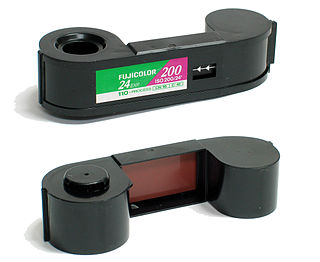
110 is a cartridge-based film format used in still photography. It was introduced by Kodak in 1972. 110 is essentially a miniaturized version of Kodak's earlier 126 film format. Each frame is 13 mm × 17 mm, with one registration hole. Cartridges with 12, 20, or 24 frames are available on-line. Production variations sometimes have allowed for an additional image.

Advanced Photo System (APS) is a discontinued film format for still photography first produced in 1996. It was marketed by Eastman Kodak under the brand name Advantix, by FujiFilm under the name Nexia, by Agfa under the name Futura and by Konica as Centuria.
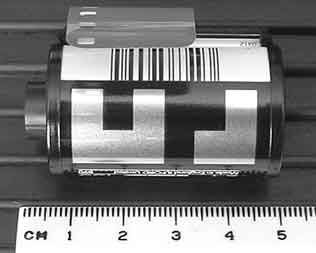
DX encoding is an ANSI and I3A standard, originally introduced by Kodak in March 1983, for marking 135 and APS photographic film and film cartridges. It consists of several parts, a latent image DX film edge barcode on the film below the sprocket holes, a code on the cartridge used by automatic cameras, and a barcode on the cartridge read by photo-finishing machines.
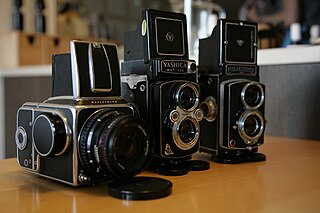
Medium format has traditionally referred to a film format in photography and the related cameras and equipment that use film. Nowadays, the term applies to film and digital cameras that record images on media larger than the 24 mm × 36 mm used in 35 mm photography, but smaller than 4 in × 5 in.
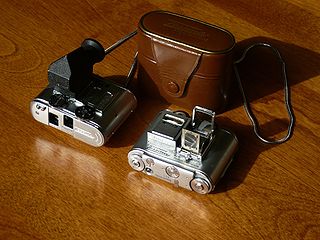
Subminiature photography is photographic technologies and techniques working with film material smaller in size than 35mm film, such as 16mm, 9.5mm, 17mm, or 17.5mm films. It is distinct from photomicrography, photographing microscopic subjects with a camera which is not particularly small.

Konica Minolta, Inc. is a Japanese multinational technology company headquartered in Marunouchi, Chiyoda, Tokyo, with offices in 49 countries worldwide. The company manufactures business and industrial imaging products, including copiers, laser printers, multi-functional peripherals (MFPs) and digital print systems for the production printing market. Konica Minolta's Managed Print Service (MPS) is called Optimised Print Services. The company also makes optical devices, including lenses and LCD film; medical and graphic imaging products, such as X-ray image processing systems, colour proofing systems, and X-ray film; photometers, 3-D digitizers, and other sensing products; and textile printers. It once had camera and photo operations inherited from Konica and Minolta but they were sold in 2006 to Sony, with Sony's Alpha series being the successor SLR division brand.
C-41 is a chromogenic color print film developing process introduced by Kodak in 1972, superseding the C-22 process. C-41, also known as CN-16 by Fuji, CNK-4 by Konica, and AP-70 by AGFA, is the most popular film process in use, with most, if not all photofinishing labs devoting at least one machine to this development process.

828 is a film format for still photography. Kodak introduced it in 1935, only a year after 135 film. 828 film was introduced with the Kodak Bantam, a consumer-level camera.
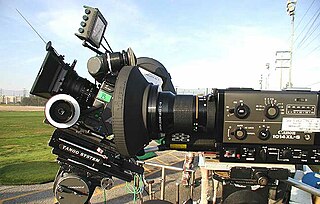
A Super 8mm camera is a motion picture camera specifically manufactured to use the Super 8mm motion picture format. Super 8mm film cameras were first manufactured in 1965 by Kodak for their newly introduced amateur film format, which replaced the Standard 8 mm film format. Manufacture continued until the rise in popularity of video cameras in the mid-1970s. In 2014 the first new Super 8mm camera in 30 years was introduced by the Danish company Logmar Camera Solutions. Most other cameras readily available are from the 1960s through the 1980s.

Analog photography, also known as film photography, is a term usually applied to photography that uses chemical processes to capture an image, typically on paper, film or a hard plate. These processes were the only methods available to photographers for more than a century prior to the invention of digital photography, which uses electronic sensors to record images to digital media. Analog electronic photography was sometimes used in the late 20th century but soon died out.

In still photography, Kodak's Kodacolor brand has been associated with various color negative films since 1942. Kodak claims that Kodacolor was "the world's first true color negative film". More accurately, it was the first color negative film intended for making paper prints: in 1939, Agfa had introduced a 35 mm Agfacolor negative film for use by the German motion picture industry, in which the negative was used only for making positive projection prints on 35 mm film. There have been several varieties of Kodacolor negative film, including Kodacolor-X, Kodacolor VR and Kodacolor Gold.

Photographic film is a strip or sheet of transparent film base coated on one side with a gelatin emulsion containing microscopically small light-sensitive silver halide crystals. The sizes and other characteristics of the crystals determine the sensitivity, contrast, and resolution of the film. Film is typically segmented in frames, that give rise to separate photographs.

Cinestill Film is a Los Angeles-based company selling photographic film for analog cameras in collaboration with Kodak motion picture cinema film stock. The two brothers who founded the company started as a small business shooting music and wedding photography, hacking cameras and lenses, then moved on to chemically adapting cinema film so it could be processed at photo labs.